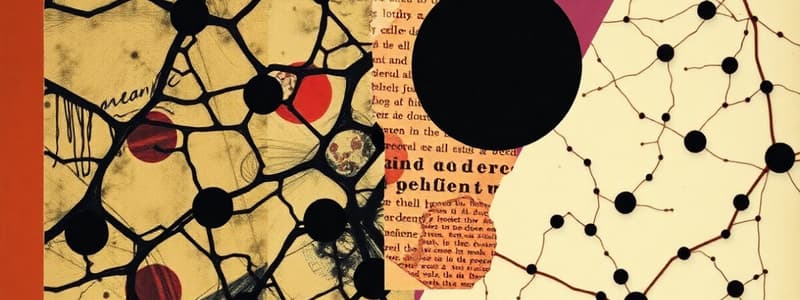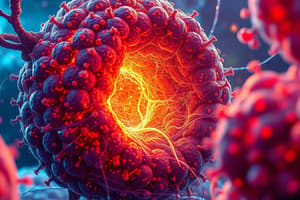Podcast
Questions and Answers
The study of biology balances the ______ strategy with the goal of understanding how the parts of cells, organisms and populations are functionally integrated.
The study of biology balances the ______ strategy with the goal of understanding how the parts of cells, organisms and populations are functionally integrated.
reductionist
In 1665, Robert Hooke observed honeycomb-like ______ cells in a thin slice of cork under a microscope.
In 1665, Robert Hooke observed honeycomb-like ______ cells in a thin slice of cork under a microscope.
dead
Anton Von Leeuwenhoek was the first to see and describe ______ cells in a drop of pond water and scrapings from his teeth.
Anton Von Leeuwenhoek was the first to see and describe ______ cells in a drop of pond water and scrapings from his teeth.
living
Matthias J Schleiden, a German botanist, concluded that all ______ are made of cells.
Matthias J Schleiden, a German botanist, concluded that all ______ are made of cells.
Theodore Schwann, a British zoologist, formulated the 'cell ______' based on his studies of animal cells.
Theodore Schwann, a British zoologist, formulated the 'cell ______' based on his studies of animal cells.
One of the tenets of cell theory is that all cells arise only by ______ of a previously existing cell.
One of the tenets of cell theory is that all cells arise only by ______ of a previously existing cell.
Modern cell theory states that the cell contains ______ information (DNA) that is passed on from cell to cell during cell division.
Modern cell theory states that the cell contains ______ information (DNA) that is passed on from cell to cell during cell division.
The activity of a cell depends on the activities of ______ structures within the cell, such as organelles, nucleus, and plasma membrane.
The activity of a cell depends on the activities of ______ structures within the cell, such as organelles, nucleus, and plasma membrane.
The ______ is a semifluid matrix that fills the interior of the cell.
The ______ is a semifluid matrix that fills the interior of the cell.
Organisms can be broadly categorized into three main domains: Archaea, Bacteria, and ______.
Organisms can be broadly categorized into three main domains: Archaea, Bacteria, and ______.
Prokaryotes, such as Archaea and Bacteria, have their genetic material located in a ______.
Prokaryotes, such as Archaea and Bacteria, have their genetic material located in a ______.
Eukaryotic cells have a ______ that houses their genetic material.
Eukaryotic cells have a ______ that houses their genetic material.
Viruses, viroids, and prions are examples of ______ entities that lack cellular structure.
Viruses, viroids, and prions are examples of ______ entities that lack cellular structure.
Flashcards
Cytoplasm
Cytoplasm
A semifluid, gel-like substance filling the interior of a cell, providing a medium for cellular activities.
Domains of Life
Domains of Life
The three main domains of life, each containing distinct characteristics: Bacteria, Archaea, and Eukarya.
Prokaryotic Cells
Prokaryotic Cells
Cells lacking a membrane-bound nucleus and other internal organelles. They have a single type of plasma membrane and their genetic material is found in a region called the nucleoid.
Eukaryotic Cells
Eukaryotic Cells
Signup and view all the flashcards
Organelles
Organelles
Signup and view all the flashcards
Reductionist Strategy in Biology
Reductionist Strategy in Biology
Signup and view all the flashcards
Who coined the term 'cell'?
Who coined the term 'cell'?
Signup and view all the flashcards
Who discovered living cells?
Who discovered living cells?
Signup and view all the flashcards
Schleiden's contribution to cell theory
Schleiden's contribution to cell theory
Signup and view all the flashcards
Schwann's contribution to cell theory
Schwann's contribution to cell theory
Signup and view all the flashcards
Cell Theory
Cell Theory
Signup and view all the flashcards
Modern Cell Theory
Modern Cell Theory
Signup and view all the flashcards
Characteristics of Cells
Characteristics of Cells
Signup and view all the flashcards
Study Notes
Cell and Molecular Biology - History and Basic Properties of Cells
- Biology balances reductionist strategies with understanding how cell, organism, and population parts work together.
- Robert Hooke (1665) observed honeycomb-like structures in cork and coined the term "cell," meaning a small room or compartment.
- Anton van Leeuwenhoek (1667) first saw and described living cells (animalcules/bacteria) in pond water and scrapings of his teeth.
- Matthias Schleiden (1838) concluded that all plants are made of cells.
- Theodor Schwann (1839) proposed the cell theory, stating that animals are also made of cells.
- Rudolf Virchow (1855) expanded the cell theory to include that cells arise only from pre-existing cells.
Cell Theory
- All organisms are made of one or more cells.
- Life processes (metabolism and heredity) occur within cells.
- Cells are the basic units of organization in organisms.
- Cells are produced from pre-existing cells.
Early Microscopes
- Early microscopes were developed and used in the 17th century.
- Galileo Galilei is credited by some historians with inventing a microscope.
- Robert Hooke designed a microscope and illustrated it in his book Micrographia.
- Anton van Leeuwenhoek built microscopes with high magnification allowing him to see bacteria and other microorganisms.
Modern Cell Theory
- Cells contain hereditary information (DNA) passed on during cell division.
- All cells have similar chemical composition and metabolic activities.
- All basic chemical and physiological activities occur within cells (e.g., movement, digestion).
- Cell activity depends on sub-cellular structures (e.g., organelles, nucleus, plasma membrane).
Characteristics of Cells
- Cell membrane (phospholipid bilayer): Controls cell function, small cells have more surface area relative to volume than large cells.
- Cytoplasm: Semifluid matrix filling the cell, containing sugars, amino acids, and proteins for cell function.
- Organelles: Structures with specific functions inside cells, containing genetic materials.
Three Main Domains of Life
- Archaea: A domain of prokaryotes.
- Bacteria: A domain of prokaryotes.
- Eukarya: A domain of eukaryotes that includes cells with membrane-bound organelles.
Cell Types of Organisms
- Prokaryotes: (Archaea and Bacteria): Single-celled organisms lacking membrane-bound organelles. Their DNA is found in a nucleoid region.
- Eukaryotes: Have membrane-bound organelles. Their DNA is located in a nucleus.
Acellular Entities
- Viruses, viroids, and prions: Are not considered cells.
- Viruses are fragments of nucleic acids (DNA or RNA) and are non-living but capable of replication.
- Viroids are smaller than viruses, consisting of RNA without a protein coat. They infect eukaryotes.
- Prions are infectious agents consisting of misfolded proteins.
Comparison of Bacterial, Animal, and Plant Cells
- A table comparing cell wall, plasma membranes, and other internal structures among these types of cells.
Studying That Suits You
Use AI to generate personalized quizzes and flashcards to suit your learning preferences.




